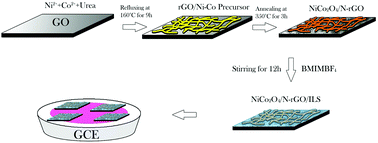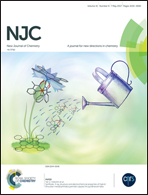Enhanced amperometric sensing using a NiCo2O4/nitrogen-doped reduced graphene oxide/ionic liquid ternary composite for enzyme-free detection of glucose
Abstract
In our work, a NiCo2O4/nitrogen-doped reduced graphene oxide/ionic liquid (NiCo2O4/N-rGO/IL) nanocomposite was prepared using hydrothermal treatment and calcination followed by a facile reaction with stirring. The composite material was characterized using scanning electron microscopy (SEM), transmission electron microscopy (TEM), X-ray diffraction (XRD), X-ray photoelectron spectroscopy (XPS), FTIR spectra and thermogravimetric analysis (TGA). The biosensing properties of NiCo2O4/N-rGO/IL, NiCo2O4/N-rGO and NiCo2O4 towards glucose were studied based on a glassy carbon electrode. The NiCo2O4/N-rGO/IL nanocomposite exhibits excellent electrocatalytic activity towards glucose, with a sensitivity of 3.76 mA mM−1 cm−2 and a good linear response from 0.001 mM to 4.555 mM at a potential of +0.5 V. The limit of detection can reach 0.18 μM. It also shows significant electrochemical sensitivity, reproducibility and long-term stability. The good electrocatalytic activity is attributed to the synergistic effect of the metal oxides, graphene oxide and the IL. The N-doping of rGO accelerates the electron transfer of the IL further and enhances its electrochemical properties. In addition, the sensor is effectively applied to the determination of glucose in a human blood serum sample.



 Please wait while we load your content...
Please wait while we load your content...